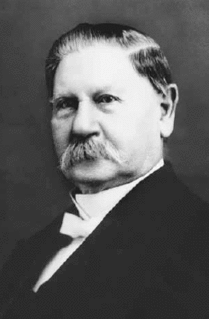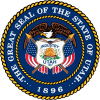
"America " is an American patriotic song, the lyrics of which were written by Samuel Francis Smith. The song served as one of the de facto national anthems of the United States before the adoption of "The Star-Spangled Banner" as the official U.S. national anthem in 1931. The melody used is the same as that of one of the de facto national anthems of the United Kingdom, "God Save the Queen".
The Finlandia hymn refers to a serene hymn-like section of the patriotic symphonic poem Finlandia, written in 1899 and 1900 by the Finnish composer Jean Sibelius. It was later re-worked by the composer into a stand-alone piece. With words written in 1940 by Veikko Antero Koskenniemi, it is one of the most important national songs of Finland. Although not the official national anthem of Finland, it has been continuously proposed as such.
"I Vow to Thee, My Country" is a British patriotic hymn, created in 1921, when music by Gustav Holst had a poem by Sir Cecil Spring Rice set to it. The music originated as a wordless melody, which Holst later named "Thaxted", taken from the "Jupiter" movement of Holst's 1917 suite The Planets.

Charles William Penrose was a member of the Quorum of the Twelve Apostles of The Church of Jesus Christ of Latter-day Saints from 1904 to 1911. Penrose was also a member of the First Presidency, serving as a counselor to church presidents Joseph F. Smith and Heber J. Grant from 1911 until his death.

"Oregon, My Oregon" is the regional anthem of the U.S. state of Oregon. Written for a song contest in 1920, the 16-line, 2-verse song became the state's official state song in 1927.
"Utah...This Is the Place" is the regional anthem of the U.S. state of Utah. It was written in 1996 by Sam and Gary Francis for Utah's centennial celebrations. It replaced "Utah, We Love Thee" as the state song in 2003, after 4th grade students at Cook Elementary wanted a song that was fun to sing. The students talked to their local state representative, Dana Love, and she drafted a bill that passed the state legislature on 28 February 2003, and was signed by then Utah Governor Mike Leavitt on 15 March 2003. The previous song, "Utah, We Love Thee", became the State Hymn.
The "North Dakota Hymn" is the regional anthem of the U.S. state of North Dakota. It was written by a poet named James Foley in 1926 in such a way that it could be sung along with the tune of "The Austrian Hymn". C. S. Putman arranged the music with distinct ragtime syncopation.

Janice Kapp Perry is an American composer, songwriter, and author. As a member of The Church of Jesus Christ of Latter-day Saints, she has written over 3,000 songs, some of which appear in the church's official hymnal and in the Children's Songbook. Some of her most well-known songs include "I Love to See the Temple" and "A Child's Prayer".
Hymns are an important part of the history and worship of The Church of Jesus Christ of Latter-day Saints.
"For the Beauty of the Earth" is a Christian hymn by Folliott S. Pierpoint (1835-1917).

Burl Ives and the Korean Orphan Choir Sing of Faith and Joy is an album by the American folk singer Burl Ives. Released on the Herald label in 1963, this is a collection of gospel hymns, most having verses and a chorus. The album also features the World Vision Korean Orphan Choir.

Evan Stephens was a Latter-day Saint composer and hymn writer. He was also the director of the Mormon Tabernacle Choir for 26 years (1890–1916).
"We Thank Thee, O God, for a Prophet" is a hymn of The Church of Jesus Christ of Latter-day Saints. It has been sung at many general conferences of the LDS Church since it was published in 1863.

Ebenezer Beesley was a Latter-day Saint hymn writer and composer. The music for twelve of the hymns in the 1985 English-language hymnal of The Church of Jesus Christ of Latter-day Saints were written by him.
"World in Union" is a theme song for the Rugby World Cup. Its melody is "Thaxted", from the middle section of "Jupiter, the Bringer of Jollity", a movement from Gustav Holst's The Planets, and was originally adapted by Holst for its use in the British/Anglican patriotic hymn, "I Vow to Thee, My Country", using words by Sir Cecil Spring Rice.
"The Island Hymn" is the patriotic song of the Canadian province of Prince Edward Island. It was first conceived early in 1908 by Professor Harry Watts of the Charlottetown School of Music who at the suggestion of Rev. Dr. Thomas Fullerton, contacted Island author and poet Lucy Maud Montgomery asking if she would compose the hymn's lyrics, which she wrote in 1908. A stanza from the "Hymn" was performed for the first time in public on May 22 of that year at a combined school event marking both Arbor Day and Empire Day. Written to the metre of God Save the King, it was sung to Lawrence W. Watson's music, which had been composed especially for her lyric at the request of Professor Watts. The full piece was not performed until school closing exercises the following June 29th, as Watts recalled, that the "Hymn" was first sung in its entirety.

The alma mater of the University of Pittsburgh was adopted soon after the University changed its name in 1908 from the Western University of Pennsylvania to its current moniker. Lyrics were written by George M. P. Baird, class of 1909 and were set to the tune of what was then the Austrian National Anthem. A new tune for the "Alma Mater" hymn was composed by Charles W. Scovel, class of 1883, but it was not widely adopted and was either lost or became obscure.

"The Hymn of Joy" is a poem written by Henry van Dyke in 1907 with the intention of musically setting it to the famous "Ode to Joy" melody of the final movement of Ludwig van Beethoven's final symphony, Symphony No. 9.










